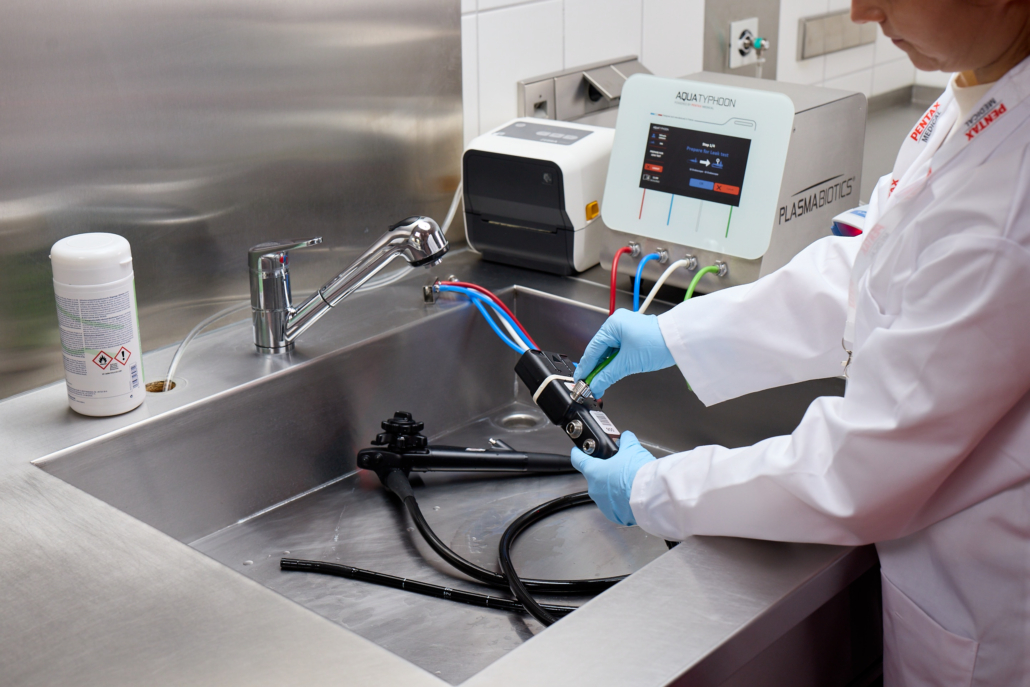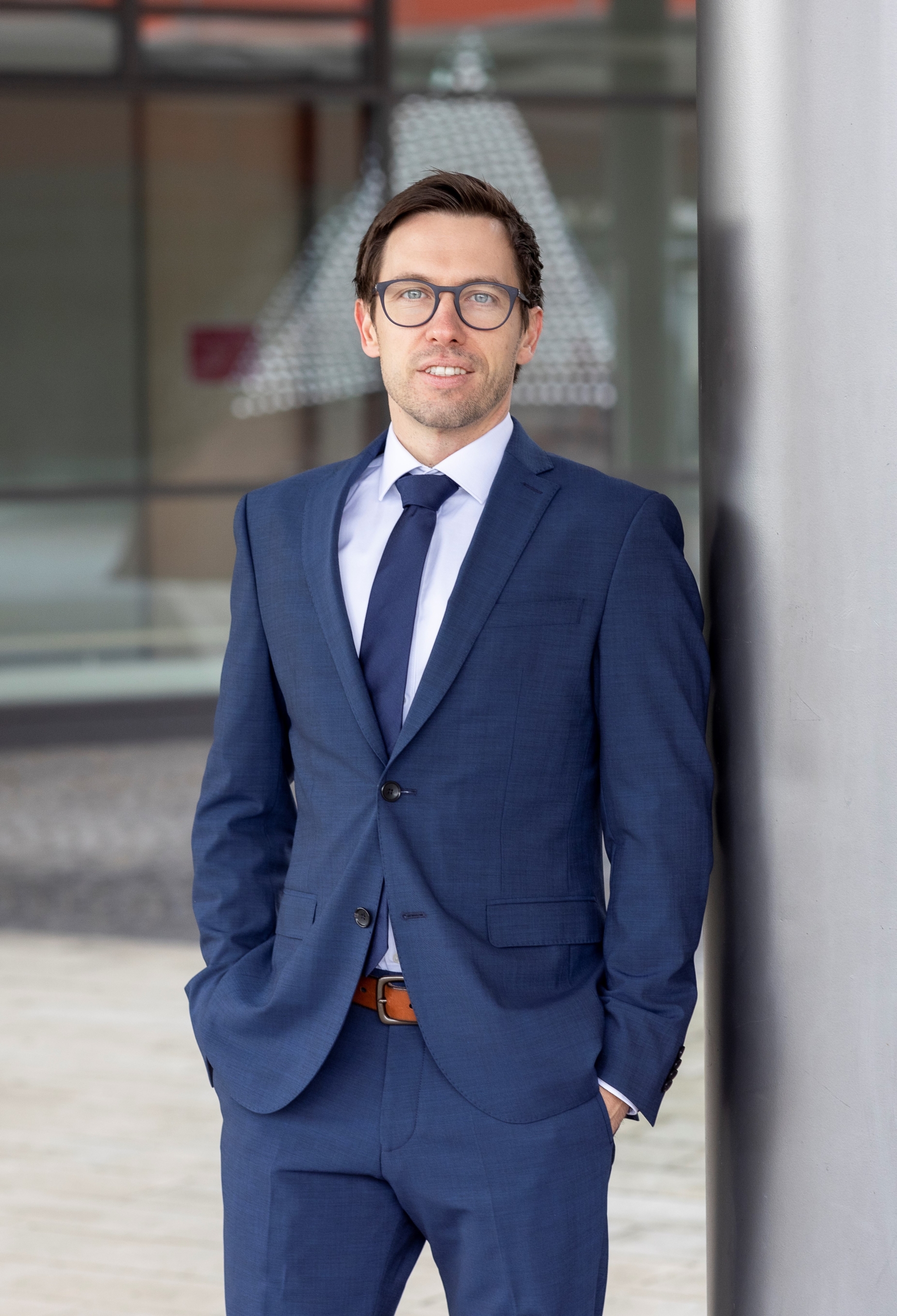PENTAX Medical’s AquaTYPHOON revolutionises cleaning of endoscopes
In the fast-evolving world of healthcare, innovation is key. The AquaTYPHOON™, a new technology recently introduced by PENTAX Medical is one such innovation. This novel device looks set to substantially improve the way endoscopy suites reprocess their reusable endoscopes. The AquaTYPHOON enhances patient safety, significantly cuts costs, and advances sustainability initiatives. In an interview with International Hospital, Harald Huber, Global VP for Product and Category Management at PENTAX Medical, sheds light on the AquaTYPHOON and its significance for patients and hospitals’ endoscopy suites.
In June this year PENTAX Medical announced the launch of their AquaTYPHOON – a novel brushless solution for the automated pre-cleaning of endoscopes. The device provides an attractive alternative to the traditional manual pre-cleaning step in reusable endoscope reprocessing.
Harald Huber, Global VP for Product and Category Management at PENTAX Medical explains: “Reusable endoscopes are reused for multiple patients and, of course, each patient naturally wants to have a clean and safe device when undergoing an endoscopic surgical procedure. This means endoscopes need to be thoroughly cleaned and disinfected before they are used on the next patient. Typically, there is a cleaning cycle for the endoscopes and this has several steps.
“Following an endoscopic surgical procedure, the first step in cleaning, or reprocessing, the endoscope involves a simple wiping down of the endoscope by one of the medical staff to remove the largest contaminants. Then it goes to the pre-cleaning step where the endoscope is placed in a sink and brushed – think of a bottle brush – with water and
detergent. This is a labour-intensive manual process where the cleaner brushes all the channels of the endoscope.”
Typical endoscopes have three distinct working channel segments: the inlet region where the biopsy port in the endoscope handpiece joins the working channel within the endoscope shaft, the uniform cylindrical channel segment
within the endoscope shaft and the channel segment at the distal bending tip characterized by circular rings.
The pre-cleaning step is just preparation for the main cleaning phase which happens in the automated endoscope reprocessor – the AER – where the cleaning and disinfecting of the endoscopes takes place.
“The AquaTYPHOON™ is designed to automate the pre-cleaning step before the endoscope is placed in the AER,” Huber clarifies.
Proprietary technology
So how does it work, exactly? The AquaTYPHOON uses proprietary technology developed by manufacturer PlasmaBiotics, a controlling share of which was acquired by PENTAX Medical, which now owns the intellectual property for the technology. Without giving too much away, Huber explains that the AquaTYPHOON uses only water and air. There is no heat or detergent. “Think of a typhoon,” he says. “The water, is accelerated by a turbulent flow. Into this very fast wind water droplets are inserted, where they are accelerated to a super high speed. This creates a shear stress which rubs off contaminants from the endoscope. It simulates the effect of a physical brush, but it’s only using air and water.”
Asked about research carried out to show the cleaning efficacy of the AquaTYPHOON compared to manual pre-cleaning of endoscopes, Huber says that advanced research is still ongoing. “However, before introducing the product to the market, we wanted to have the confirmation that this automated pre-cleaning process is an improvement on the manual pre-cleaning process. We compared the AquaTYPHOON to the classical brush and detergent cleaning to understand the difference. We did microbial testing and looked at the residual protein on the endoscope following cleaning to show equivalency and superiority over manual pre-cleaning.”
Interestingly, Huber adds that they have had a lot of interest from their clinical partners around the world who have approached them to do studies to show the AquaTYPHOON’s effectiveness in their facilities – to show how it compares to the manual, traditional cleaning, and how they actually benefit from using such a system over traditional brush cleaning. The results of these studies are still forthcoming.
Compatibility with different endoscopes
The AquaTYPHOON is compatible with a wide variety of endoscopes from different manufacturers. “We have validated this for all the main models of all major manufacturers of reusable endoscopes. But we still advise our clinical partners or customers who are interested in the AquaTYPHOON to get in contact with a local PENTAX Medical rep to confirm if it is compatible with their endoscopes,” Huber says.
Asked about how long it typically takes to pre-clean an endoscope with the AquaTYPHOON, Huber explains that as there are many different types of endoscopes and that they verified typical cleaning cycle times for these different endoscopes. “The most complex of the endoscopes is the so-called EUS or endoscopic ultrasound endoscope. It has a small ultrasound sensor on the tip of the endoscope, where you can have a normal camera image, but at the same time, an ultrasound image. This is a complex endoscope, because it has this additional sensor and additional mechanical features, to angulate accessories like a needle during ultrasound image acquisition, for example. This is the most complex endoscope and for this we established a cycle of seven minutes. So this is the longest cycle.” “Then we have the typical GI scopes, like you have for colonoscopy or gastro procedures. For these we established a five-minute cycle. And then we have small calibre scopes, like bronchoscopes for the lungs. We established a two-minute cycle for these scopes. The guidelines usually recommend around 20 minutes for the manual clean, so this is a significant time-saving,” he emphasises.
Endoscope cleaning protocols
Discussing established endoscope cleaning protocols, Huber points out that they have had to follow these protocols, because this is what the market demands. “Typically, hospitals have a checklist and they check box each of the cleaning steps, and when complete they sign a protocol. What we did for AquaTYPHOON – at the end of the cycle, when everything went well – it issues a traceability label which can be printed out and attached to the specific endoscope that has been cleaned. So you can make sure when you scan it later on with the barcode scanner, or with the QR code scanner, you can see that this scope has been cleaned according to the appropriate cycle.
“Also, it provides electronic traceability, which can be uploaded to the hospital database, so at any point in time you can check the condition of each scope,” he adds.
Harald Huber,
Global VP for Product and Category Management at PENTAX Medical.
Ease of use and human error mitigation
Regarding the AquaTYPHOON’s ease-of-use, Huber says this is one of the biggest benefits. “With the AquaTYPHOON you simply connect the channels to the machine, press the start button, and it runs the cycle automatically.” This simple automation not only expedites the process, but also mitigates the risk of human error.
The AquaTYPHOON also has safety features such as a pressure sensor and a moisture sensor, which provide an alert signal if something is wrong with the scope.
Cost reduction and sustainability
The benefits of the AquaTYPHOON transcend simple efficiency and extend to significant cost reduction and enhanced sustainability. Huber elaborates: “By automating and speeding up the reprocessing of endoscopes, we make
it easier for already stretched hospital staff to handle more endoscopes more efficiently.”
Additionally, the marked reduction in single-use items such as detergents and brushes results in substantial cost savings.
“In our pilot hospital programme, when we were testing the device, we made sure that we had different hospitals with a different number of procedures each year. We had some hospitals with 7000 procedures per year, and bigger hospitals with more than 10,000 procedures per year. At these pilot sites we were able to confirm that the costs that are necessary for manual pre-cleaning can be reduced by as much as 80%, which is huge,” Huber points out.
Turning to the subject of sustainability, which is now on many hospitals’ agendas as the world moves to combat climate change, Huber notes that this is of primary importance to PENTAX Medical.
He explains how the AquaTYPHOON can substantially advance a hospital’s sustainability initiatives. “In the normal, traditional manual pre-cleaning of endoscopes with a brush there is a lot of water use, because you have to drown the scope. You have to use detergents, which are pollutants. All of this is done with consumables, such as the brushes which are not reusable. It is not just the single-use brushes that are a problem, but also the packaging they come in. All of this adds up to a mountain of waste, which can be completely eliminated by the AquaTYPHOON.
“We established four pilot sites across Europe, where we collect data to confirm and also understand how the AquaTYPHOON helps in terms of waste reduction, water consumption, and so on. At these pilot sites we found we were able to reduce waste by 99% when compared to manual pre-cleaning and reduce water consumption up to 85%.”
Taking all this into account, the introduction of the AquaTYPHOON is expected to be a significant game-changer with regards improved efficiency, cost reduction and sustainability for hospitals and their endoscopy suites.
To date, the AquaTYPHOON has received the CE mark and is commercially available on the European market. Huber says they are in the process of applying for US FDA approval.




